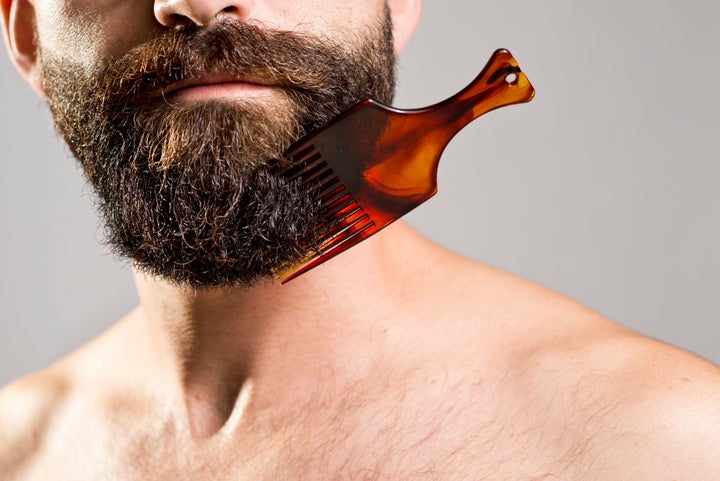Facial hair changes are common with age, but they could also potentially happen at any time. Here’s why.
You probably expect your facial hair to turn gray as you get older, but you might not expect your beard to become thinner and patchier.
Doctors say these facial hair changes are common with age, but they could also potentially happen at any time. And there could be several reasons why.
“Men’s beards undergo several changes over time due to aging, hormonal shifts and environmental factors,” said Dr. Oma Agbai, director of multicultural dermatology and hair disorders at the University of California, Davis School of Medicine.
But don’t dismiss any facial hair loss or changes as simply age-related, she emphasized. “If the facial hair loss is sudden, rapid, symptomatic, or resulting in completely smooth patches, [you] should not hesitate to consult a dermatologist.”
If you notice you don’t need to shave your beard as often as you used to, you might wonder why. Here are some common reasons your facial hair may be changing and what you can do about it.
The Causes Behind Facial Hair Changes
Hair color, thickness and growth pattern changes are typical ways facial hair can shift, Agbai said.
Like the hair on your head, beard hair often turns gray or white with age, she said. It’s due to the depletion of melanocyte stem cells in your hair follicles, which decreases pigmentation. Genetics, environmental factors, medical conditions and mental health problems, like stress, can accelerate graying.
You might also notice your beard isn’t as full as it used to be, or that it grows more slowly, explained Dr. Damon Tanton, a physician board-certified in endocrinology, diabetes and metabolism and the medical director for the AdventHealth Diabetes Institute.
“Typically, beards (and mustaches) start to lose their thickness as men approach their 40s, about the same time that the hairs start to gray,” he said.
It’s also around the time men start to experience declining levels of the hormone testosterone, which contributes to hair loss. Dr. Richard Bottiglione, a board-certified dermatologist, told HuffPost that when testosterone levels are low, hair follicles don’t get enough of the hormone that they need for hair to grow — so it can decrease facial and body hair.
Genetics, nutrition, stress and medical conditions, such as metabolic syndrome and obesity, might also contribute to facial hair changes, Agbai said. Insulin resistance is potentially another cause, Tanton added.
Skin- and hair-related conditions, such as alopecia areata, pseudofolliculitis barbae, lichen planopilaris and severe seborrheic dermatitis, could also be to blame for facial hair changes, Agbai said. These conditions can affect anyone of any age.

When To See A Doctor
If your slow-growing beard or its patchy appearance bother you, Bottiglione recommends seeing a dermatologist.
Agbai also encouraged making an appointment, especially if your facial hair loss is accompanied by itching, redness, tenderness, scaling or bumpiness. Doctors will assess your symptoms and identify any underlying health issues that need to be treated.
Your doctor may also recommend getting your testosterone levels checked, Tanton said, especially if you have other symptoms like a low libido, erectile dysfunction, sleep problems or fatigue. This is done by a simple blood test.
Blood tests might also be recommended if doctors suspect you have insulin resistance, prediabetes or diabetes, which can also contribute to facial hair changes, Tanton said.
How To Treat Facial Hair Changes
You can always dye a graying beard. But with other changes, you really need a doctor’s help. Bottiglione said doctors will recommend the best treatment based on what’s causing the problems, whether it’s hormonal or an underlying medical condition. “You have to look at these things and find a treatment that works best for you and your goals,” he said.
If your testosterone levels are low, you may need testosterone replacement therapy (TRT), which Agbai said can improve facial hair. However, the medication can cause some side effects, including decreased fertility, so it’s important to work closely with your doctor.
For insulin resistance, doctors may recommend lifestyle changes, like weight loss, an exercise regimen or dietary changes, as well as medication, according to the Cleveland Clinic.
When you have alopecia areata or another hair or skin condition, Agbai said dermatologists would likely prescribe medications such as finasteride or oral minoxidil. Microneedling, platelet-rich plasma therapy and injectible steroid treatments can also help stimulate hair growth.
“The effectiveness depends on the underlying cause,” Agbai noted.
Generally, taking good care of your skin is also important for good beard growth, Bottiglione said. He recommended regularly using glycolic acid to help keep your pores from getting clogged and prevent ingrown hairs, especially if you shave.
The American Academy of Dermatology also suggests washing your face and beard daily with a fragrance-free, non-comedogenic cleanser, meaning it won’t clog your pores. Also, moisturize your skin and facial hair after shaving and wear sunscreen of at least an SPF 30 every day.
Credit: Source link